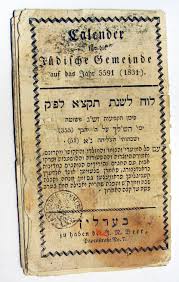Kalendarz Żydowski

Żydzi przejęli rachubę mierzenia czasu od Babilończyków. Oczywiście z drobnymi zmianami, wynikającymi z odmienności religii, kultur i zwyczajów.
Żydowski rok zaczynał się początkowo — podobnie jak u Babilończyków — pierwszego dnia Nisan, a więc w kwietniu. Później przeniesiono go na dzień pierwszy Tisri (października).
Żydzi również regulowali rachubę lat, dorzucając do niektórych z nich trzynasty miesiąc. Postępowali tak przede wszystkim ze względów religijnych. Mianowicie — 14 Nisan, w czasie pełni Księżyca, zabijali w ofierze jagnię wielkanocne. Na drugi dzień, 15 Nisan, zaczynało się święto Paschy, trwające 8 dni. W dniu 16 Nisan ofiarowywano Jahwe pierwociny plonu jęczmienia. Z tych względów konieczne było, aby miesiąc. Nisan zbiegał się z okresem, w którym w Palestynie dojrzały jęczmień nadawał się do ścięcia. Jeśli więc stwierdzano, że jęczmień na dzień 16 Nisan nie wyda ziarna (a więc kiedy nastąpiła wyraźna rozbieżność w rachubie czasu), najwyższy kapłan dorzucał do owego roku jeden miesiąc, podwajając miesiąc Adar, czyli marzec. Nowy miesiąc otrzymywał nazwę Weadar, czyli drugi Adar. Wielkanoc przesuwała się wówczas automatycznie o 30 dni.
Żydzi przejęli też od Babilończyków miesiące i to bez większych zmian, bo nawet nazwy różnią się niewiele. Oto one:
| Nisan | kwiecień | Ab | sierpień | Kislet | grudzień |
| Ijar | maj | Elul | wrzesień | Tebet | styczeń |
| Siwan | czerwiec | Tisri | paździer-
nik |
Sebet | luty |
| Tamuz | lipiec | Merczes-
wan |
listopad | Adar | marzec |
Używano także 7-dniowego tygodnia. Rozpoczynał się on w nasz piątek o zmierzchu i kończył po 7 dniach, czyli w następny piątek z chwilą zapadnięcia zmierzchu. W ten sposób zaczynał się Sabat — dzień odpoczynku (kończył się w sobotę o zmierzchu). Następne dni nazywano w kolejności I, II, III, IV i V. Ostatni dzień przed Sabatem nosił nazwę Parasew — przygotowanie.
W Palestynie unikano dwóch dni świątecznych obok siebie. Dlatego pierwszy dzień roku, obchodzony bardzo uroczyście, nie mógł wypadać w dni sąsiadujące z Sabatem. Unikano również środy (III dnia), ponieważ niewygodnie było rozpoczynać nowy rok w środku tygodnia, zwłaszcza gdy początek roku ustalił się na miesiąc Tisri (październik). Jeśli pierwszy Tisri przypadał na niewygodny dzień, powiększano rok o jedną dobę, następny zaś rok zmniejszano.
Jak z tego wynika, kalendarz żydowski był dość płynny. Bodaj jedyny w świecie, gdzie rok występował aż w sześciu wariantach, a mianowicie: 3 rodzaje roku 12-miesięcznego (rok regularny o 354 dniach, rok powiększony — o 355 i rok skrócony — 353 dniach) i 3 rodzaje roku 13-miesięcznego (rok o 384, 385 i 383 dniach). Rok żydowski liczył więc od 353 do 385 dni. Lata liczono początkowo od ważnych wydarzeń historycznych, np. od wyjścia z Egiptu lub od niewoli babilońskiej. Później ustalono rachubę lat od… stworzenia świata. Według kapłanów żydowskich, miało się to wydarzyć w 3761 r. p.n.e.
Również z Babilonii przejęto zwyczaj każdorazowego wyznaczania początku miesiąca. Nikt z urzędu nie obserwował nieba. Żydzi mieli obowiązek zawiadamiania sędziego w Jerozolimie o pojawieniu się młodego Księżyca. I jeśli co najmniej pięciu zawiadomiło o tym — sędzia orzekał początek miesiąca. A gdy Księżyc był niewidoczny z powodu zachmurzenia lub piaskowej burzy? Wtedy… miesiąc liczył 30 dni. Uporządkowanie kalendarza żydowskiego nastąpiło w IV w. n.e. Dzieła tego dokonał rabin Hillel, patriarcha z Tyberiady. Wprowadził 19-letni cykl: 12 lat zwyczajnych, liczących po 12 miesięcy (na przemian 29 i 30-dniowych) i 7 lat przestępnych, liczących po 13 miesięcy (również 29 i 30-dniowych).
Lata liczono różnie: od „stworzenia świata” lub od tzw. ery Seleucydów – zapoczątkował ją Seleukos I Nikator — założyciel dynastii greckiej Seleucydów, panującej w Azji Mniejszej od 312 do 64 r. p.n.e., wyprzedzającej naszą o 312 lat. Do XI w. n.e. była ona nawet częściej stosowana niż od stworzenia świata. Począwszy od tego wieku zwyciężyła ostatecznie era „od początku świata”.
